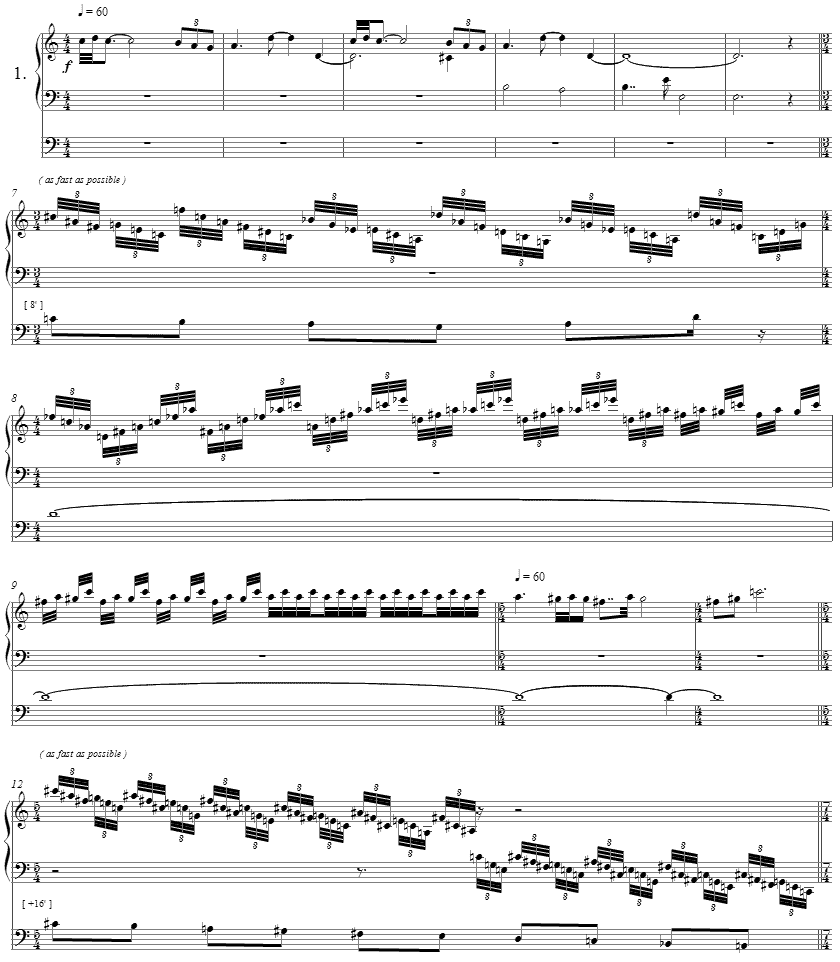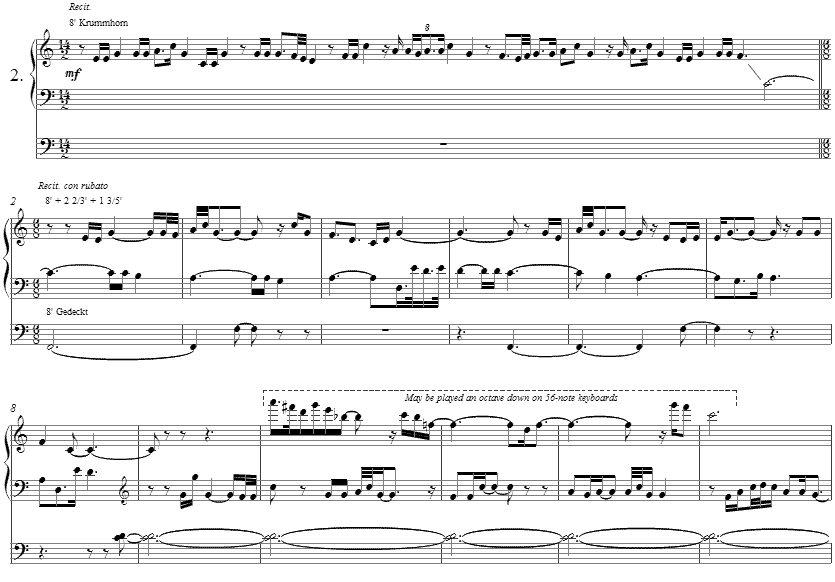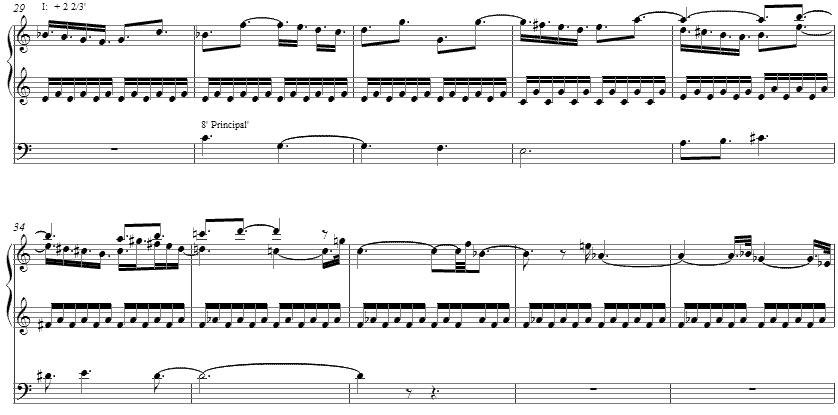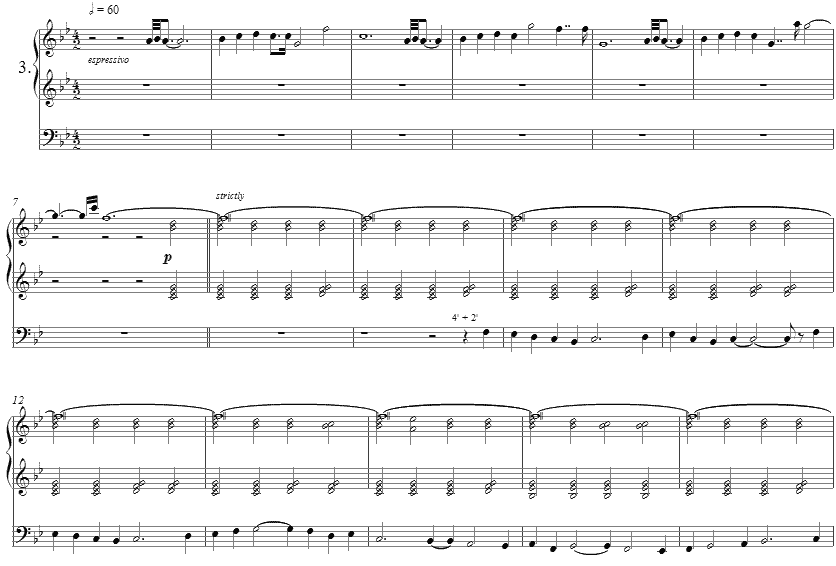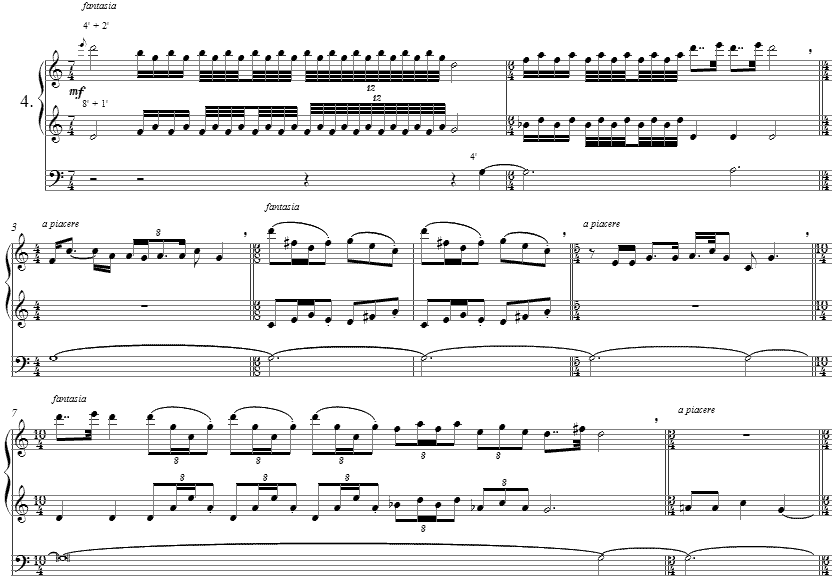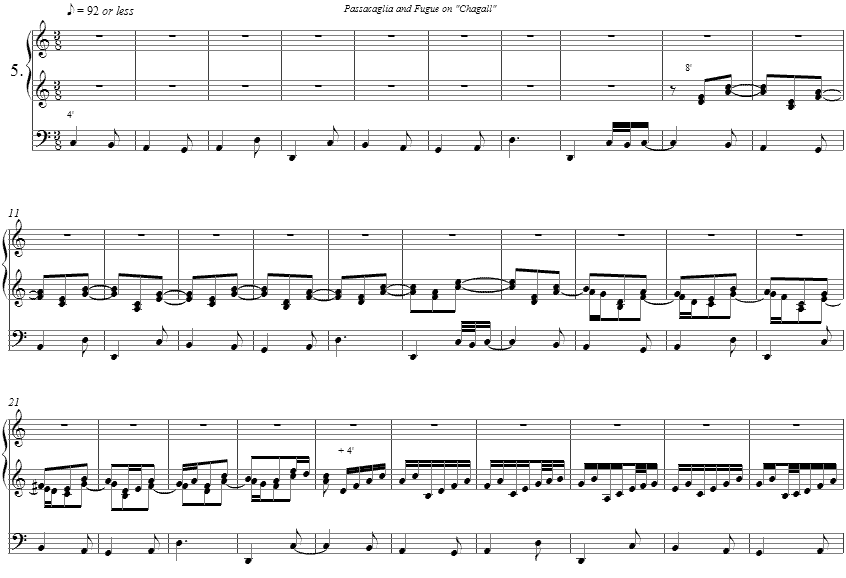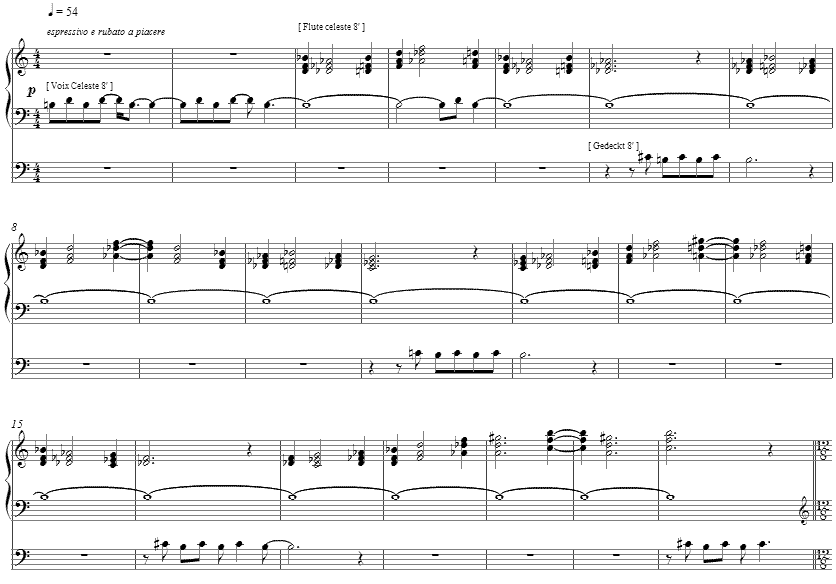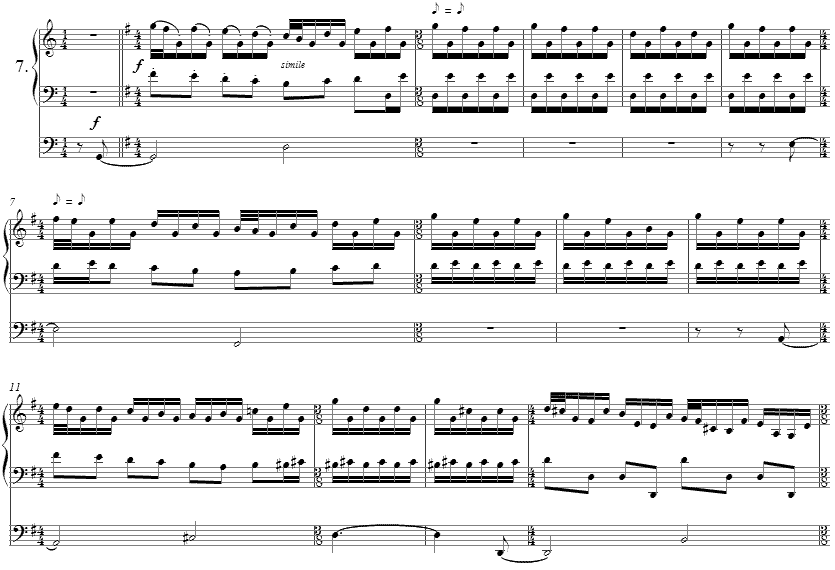Music and Texts of GARY BACHLUND Vocal Music | Piano | Organ | Chamber Music | Orchestral | Articles and Commentary | Poems and Stories | Miscellany | FAQs |
The Jerusalem Windows - (1993)
for Organ
i. Color, Form and Light
ii. Among the ladders of light
iii. Modest Gifts
iv. Glass
v. Transformations and Convergences
vi. Eternity Regained
vii. Hallel - Jewels for a Crown[ Approximate duration - 49' 00" ]
Marc Chagall was born in Vitebsk, Byelorussia to a poor Hassidic family. The eldest of nine children, he studied first in a cheder or Jewish religious school before moving to a secular Russian school, where he began to display his artistic talent. With his mother's support, and despite his father's disapproval, Chagall pursued his interest in art, going to St. Petersburg in 1907 to study art with Leon Bakst. Influenced by contemporary Russian painting, Chagall's distinctive, child-like style, often centering on images from his childhood, began to emerge. From 1910 to 1914, Chagall lived in Paris, and there absorbed the works of the leading cubist, surrealist, and fauvist painters. It was during this period that Chagall painted some of his most famous paintings of the shtetl or Jewish peasant village, and developed the features that became recognizable trademarks of his art. Strong and often bright colors portray the world with a dreamlike, non-realistic simplicity, and the fusion of fantasy, religion, and nostalgia infuses his work with a joyous quality. Animals, workmen, lovers, and musicians populate his figures; the "fiddler on the roof" recurs frequently, often hovering within another scene. Chagall's work of this period displays the influence of contemporary French painting, but his style remains independent of any one school of art. He exhibited regularly in the "Salon des Independents."
In 1914, before the outbreak of World War I, Chagall held a one-man show in Berlin, exhibiting work dominated by Jewish images and personages. During the war, he resided in Russia, and in 1917, endorsing the revolution, he was appointed Commissar for Fine Arts in Vitebsk and then director of the newly established Free Academy of Art. The Bolshevik authorities, however, frowned upon Chagall's style of art as too modern, and in 1922, Chagall left Russia, settling in France one year later. He lived there permanently except for the years 1941 - 1948 when, fleeing France during World War II, he resided in the United States. Chagall's horror over the Nazi rise to power is expressed in works depicting Jewish martyrs and Jewish refugees.
In addition to images of the Hassidic world, Chagall's paintings are inspired by themes from the Bible. His fascination with the Bible culminated in a series of over 100 etchings illustrating the Bible, many of which incorporate elements from Jewish folklore and from religious life in Vitebsk. Chagall's other illustrations include works by Gogol, La Fontaine, Peretz, and his autobiographical Ma Vie (1931; My Life 1960) and Chagall by Chagall (1979).
Chagall painted with a variety of media -- oils, water colors, and gouaches. His work also expanded to other forms of art, including ceramics, mosaics, and stained glass. Among his most famous building decorations are the ceiling of the Opera House in Paris, the two huge murals at the New York Metropolitan Opera, a glass window at the United Nations, and decorations at the Vatican. Israel, which Chagall first visited in 1931 for the opening of the Tel Aviv Art Museum, is likewise endowed with some of Chagall's work, most notably the twelve stained glass windows at Hadassah Hospital and wall decorations at the Knesset. Chagall received many prizes and much recognition for his work. He was also one of very few artists to exhibit work at the Louvre in their lifetime.
Images of the Jerusalem windows in the synagogue itself may be found at the Hadassah website, http://www.hadassah.org.il. Click on the language of choice and the look under the "About" tab and the "Art at Hadassah" for the "Chagall Windows."
This is a seven movement symphony for organ, based on visual elements in Marc Chagall's designs for the stained glass windows in the Hadassah Synagogue in Jerusalem, and more fundamentally based on the name, Chagall, itself.
Heeding a standard musical tradition I chose to use this cipher to create the musical spelling of C-H-A-G-A-L-L, the B natural in the German system called "H."
Therefore the theme after Chagall may be notated:
[ Click on the above graphic to hear the theme ]
Seeing Chagall’s stained glass for the restored cathedral in Metz in 1959, architect Jacob Neufeld invited Chagall to create a cycle of windows on the Twelve Tribes of Israel for the synagogue of the Hadassah-Hebrew University Medical Center in Jerusalem. Chagall worked with Charles Marq, master glassmaker and director of the Jacques Simon workshops in Reims, France. In 1962, after an exhibition of the windows in the courtyard of the Louvre in Paris the year before, the windows were shipped to and installed in the synagogue in the Jerusalem hospital.
Autographing the windows, Marc Chagall imposed his art upon the medium of stained glass in the cycle of windows on the Twelve Tribes of Israel. The textual inspirations include Genesis 49:3-27, the naming and blessing of Jacob’s sons, Deuteronomy 33:1, Moses’ blessings for the tribes, and Exodus 28: 15-21, the description of Aaron’s breastplate.
I had traveled to Jerusalem as a principal guest artist of the Frankfurt Opera (under the direction of Maestro Gary Bertini) for the Jerusalem Festival, and there saw these spectacular windows for the first time.
Other composers have been inspired by the cycle of stained glass windows, including Israeli composer Jacob Ben-Gilboa in his twenty-four movement work alternating choral and instrumental textures), Dutch composer Petr Eben in his work for trumpet and organ of four movements titled with the basic window color schemes, and English composer John McCabe in an orchestral suite of twelve movements, each son/tribe receiving individual treatment. It was the intent in this suite for organ to isolate the ideas and processes incorporated by Chagall in designing and manufacturing the windows, and metaphorize the views expressed by Chagall himself regarding his craft and art.
Themes: the main theme of the piece in a musical spelling of the artist’s name, C-H-A-G-A-L-L, in which the older European system’s “H” is the modern scale’s “B,” and the “L” becomes “D,” based on the tribute composed by Maurice Duruflé for his teacher, Jehan Alain. Hebraic tropes were used to make melodic the names for the sons/tribes for each window. One of the Ashkenazic tropes was employed, because of Chagall’s Russian birth and lengthy stay in France, both considered to be within the Ashkenazic European Jewish experience. The use of palindromes as structure convey the sense of viewing the windows from both sides, illuminated from outside in daylight, and illuminated from within at nighttime. The second movement’s opening is the Ashkenazic cantillation for Genesis 49:1. Other textual interpretations through trope include Genesis 49:3-22. Thus the melodic materials are drawn from many European sources in interpreting the biblical texts.
In his own words, Marc Chagall offered up his “modest gift” as an artist to the synagogue, to the world of art and to all people. I believe this statement is a remarkable and honest one, as, at this time in his life, the elements of youthful ego had long since passed in favor of an attitude of service and obedience to art and spirit.
i. Color, Form and Light
This opening movement begins with the statement of the "Chagall" theme, which naturally modulates from C to D, and therefore is stated at the outset as such, the second statement in C beginning counterpoint to a broader statement in the alto voice in D. A virtuosic display follows amid restatements of the theme, and then a long lined meditation to end the first movement.
"Color, Form and Line" - MP3 file. [ circa 7' 30" ]
ii. Among the ladders of light
The second movement begins with a solo reed in imitation of the Torah cantillation for that biblical portion of text which speaks about the twelve tribes of Israel, the overall theme for Chagall's twelve windows. A lengthy development of the Chagall theme then follows with Torah trope motives dotting the musical landscape.
After that opening gambit of biblical cantillation and continued exposition of the theme, a development follows, the theme's penchant for moving from tonal region to tonal region being further developed. In the following few measures, the head motive of the theme is stated on B flat, again in F, then G, D and E in quick succession.
"Among the ladders of light" - MP3 file [ circa 12' 00" ]
iii. Modest Gifts
This movement takes its title from one of Chagall's own comments on his talents as a painter and sculptor. That self-effacing attitude stands in stark contrast to the posture of many modern artists who proclaim themselves almost messianic in their contribution to Western culture, but whose works do not measure up to their rhetoric. The Chagall theme is stated in inversion, and then in its original orientation used as a head motive for the pedal solo over gently shifting chords.
"Modest Gifts" -- MP3 file [ 5.09 MB, 5' 25" ]
iv. Glass
A fantasia with an improvisatory flair follows -- a meditation on the brittle quality of the materials with which stained glass windows are fabricated. Chagall worked long hours alongside the artisans who brought his designs to life, and labored to add loving detail to his designs with lead paint, on top of the various colors of glass used. Torah cantillation for the names of the twelve tribes of Israel are embedded within the fantasia's episodes.
"Glass" -- MP3 file [ circa 5' 25" ]
v. Transformations and Convergences
An extended passacaglia and fugue over the Chagall theme follows the fantasia. The successive "strophes" become more and more complex in terms of texture and content, building to a final statement. The opening pedal line is played in the 4' register, sounding two octaves higher than notated. Thus the first variation's treble voices sweetly cross the theme in that register. Unlike the other movements wherein the Chagall theme forces a modulation, this passacaglia generally roots itself in the tonic, returning for each successive variation.
"Transformations and Convergences" - MP3 file [ circa 9' 55" ]
vi. Eternity Regained
The penultimate movement is a quiet meditation on the many changing colors and subtleties of Chagall's work in stained glass, as they are meant in the setting of the synagogue to point our thoughts towards the eternal. The simple B-D relationship is drawn from the second movement's small accompaniment details, as the lengthening harmonic foreground adds more tonal regions to the entire gesture, before a long-lined adagio becomes apparent.
"Eternity Regained" - MP3 file [ circa 4' 50" ]
Also available in a separate single edition is the adagio movement, Eternity Regained.
vii. Hallel - Jewels for a Crown
The last movement is a toccata, additive in its structure. Its title represents the brilliant grandeur of these twelve windows, displayed in the cupola of the synagogue, three windows on each of four sides, much like a crown for the building itself, and referring also to the Jewish notion of the "crown" of a good name, that goal of a well-lived life. Hallel is the word for praise, as better known in the forms, Hallelujah or Alleluia. The final gesture for the work, however, is not the bombast of the toccata, but a withdrawal into the meditative quiet of the overall theme of the work -- Chagall and his masterpiece meant to inspire prayer and devotion towards God.
"Hallel.- Jewels for a Crown" MP3 file [ circa 5' 45" ]
"The Jerusalem Windows" - in one complete MP3 file - [ circa 49' 00" ]
This work was written in partial fulfillment of my Doctor of Philosophy degree in Music at the University of California, Los Angeles, in 1993, guided by Professors Thomas Harmon, Henry Hopkins, Ian Krouse and Roger Bourland as chairman shown below, and premiered by Timothy Howard, in partial fulfillment of his Doctor of Musical Arts degree in organ at the University of Southern California. For the premiere, he staged a multimedia event at All Saints Church, Pasadena, projecting images of Chagall's stained glass around the church itself during the recital. I am most grateful to him for a fine first performance.
Thomas Harmon, Henry Hopkins, Ian Krouse, Roger Bourland
The complete score for The Jerusalem Windows is available as a free PDF download, though any major commercial performance or recording of the work is prohibited without prior arrangement with the composer. Click on the graphic below for this organ score. Please note this score is 64 pages in length.
